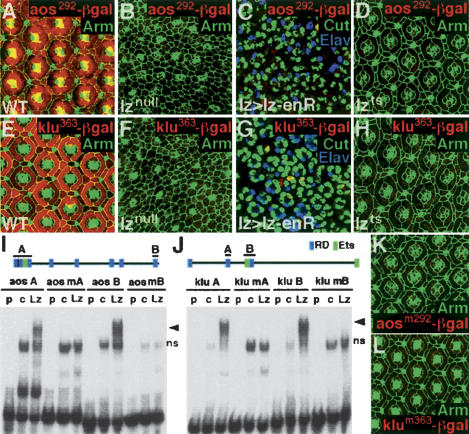Figure 3.
Lz directly activates aos292–lacZ and klu363–lacZ. Arm (green) delineates cell boundaries (A,B,D,E,F,H,K,L) and Cut (green) marks cone cell nuclei (C,G). The retinas were stained with anti-β-gal (red) and are 42 h APF unless otherwise noted. (A,E) Wild-type expression patterns of aos292–lacZ (A) and klu363–lacZ (E). (B,F) The expression of aos292–lacZ (B) and klu363–lacZ (F) is abolished in lznull pupal retinas. (C,G) In lz-Gal4 UAS-lz-enR retinas the expression of aos292–lacZ (C) and klu363–lacZ (G) is absent (Elav in blue marks the photoreceptors; retinas are <42 h APF). (D,H) Temperature-shifted lzts retinas do not express aos292–lacZ (D) and klu363–lacZ (H). (I,J) EMSAs with radiolabeled oligonucleotide probes containing wild-type or mutant RD sites from the aos292 and the klu363 enhancers. (p) Probe alone, (c) control lysate, (Lz) Lz lysate; (ns) nonspecific band. The arrowhead points to the Lz–DNA complex. Above each EMSA is a cartoon of the aos292 or klu363 enhancers with lines above the binding sites used as probes; (blue boxes) RD sites, (green boxes) Ets sites. (I) Lz forms a complex with two different aos292 probes containing RD sites 1, 2, 3 (aos A) and RD site 8 (aos B). Although aos A contains three putative RD sites, there is no evidence that multiple Lz molecules are bound because the shift is similar to aos B, which has only one RD site. Lz also binds to RD site 4 (data not shown). Lz does not bind to probes with mutant RD sites (mA, mB). (J) Lz binds klu363 probes containing RD sites 2 and 3 (klu A and klu B, respectively). Lz also binds to a probe containing RD site 1 (data not shown). Lz does not bind to probes with mutant RD sites (mA, mB). (K,L) Mutating all the RD sites in each enhancer abolished expression of both reporters: aos292mRD–lacZ (K) and klu363mRD–lacZ (L).

